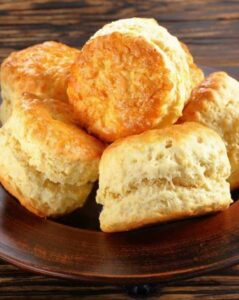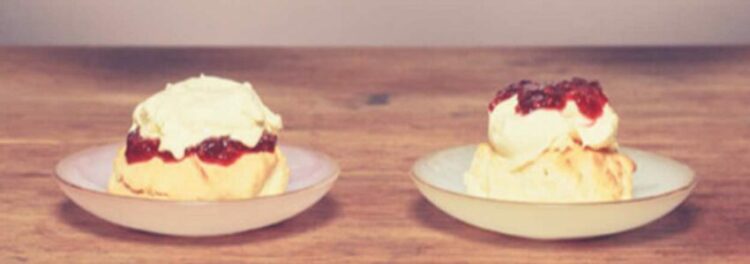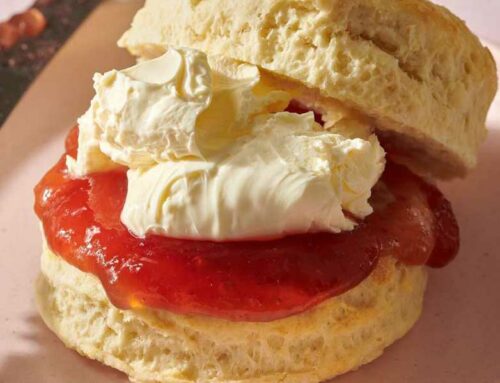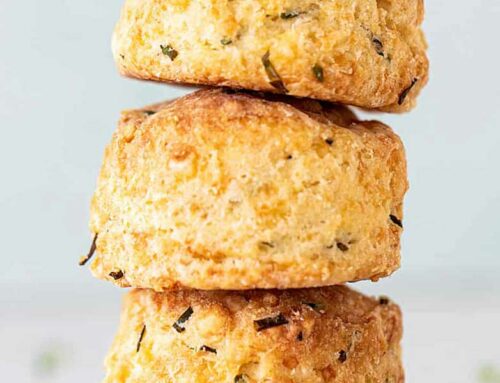So You Want To Eat A Scone? Part III
 Eating a scone as part of a cream tea is a tricky business. One does not just pick up the biscuit and eat it. There are weighty matters to be determined. One can skip over the conundrum of how to pronounce the name of the delicacy itself by pointing to it. (See Scones, Part II: What to Know Before You Eat One.) However, before eating a scone, one must prepare it.
Eating a scone as part of a cream tea is a tricky business. One does not just pick up the biscuit and eat it. There are weighty matters to be determined. One can skip over the conundrum of how to pronounce the name of the delicacy itself by pointing to it. (See Scones, Part II: What to Know Before You Eat One.) However, before eating a scone, one must prepare it.
There are a number of elements to consider with regard to scone preparation. The scone itself must be warm. What type of jam will you use? I prefer raspberry, but strawberry is also an option. The clotted cream must be cold but spreadable. Some people say unsalted butter should be used as well, but that does not seem to be traditional.
Next one must determine where one will be eating this confection. There are two different regional varieties of scone preparation: Devon and Cornwall. One would not want to scandalize the denizens of Devon by eating a scone in the Cornwall manner! Or, even worse, make the faux pas of eating a scone in Cornwall in the Devon manner!
To begin scone preparation, one should pull the scone apart, separating the top from the bottom (no knives please. Cutting with a knife condenses the crumb.) The other method is to break off a bite size piece of the biscuit. Now here is the crucial point: does one put the jam on first or does one first apply the cream? (If there is butter involved, that goes on first.)
If you are from Devon, the cream is slathered on the bottom part of the scone. Then it is topped with the jam. If you are from Cornwall, a liberal amount of jam is applied to the bottom half of the scone and then a large dollop of cream is placed on top.
The clotted cream first approach is known as the “Devon method.” The jam on first” is the Cornish method. Debrett’s, the British publisher and acknowledged authority on etiquette, behavior and the peerage (founded in 1769,) asserts that a scone should be eaten in the Cornish manner, jam first and then cream. For the Royalists among us, it is interesting to note that, according to Darren McGrady, a former royal chef, the late queen ate her scones in the Cornish manner.
A prepared scone.
Left: Cornish Method. Right: Devon Method
 While the origin of the cream tea is somewhat shrouded in the haze of history, some historians believe that the act of putting jam and cream on bread may have originated in Devon at Tavistock Abbey during the 11th century. Apparently, the Abbey was badly damaged by the Vikings in 997 C.E… The people who worked on the reconstruction were supposedly rewarded by the monks who lived there with bread topped with clotted cream and strawberry jam. The order of the application of the cream and the jam is not recorded.
While the origin of the cream tea is somewhat shrouded in the haze of history, some historians believe that the act of putting jam and cream on bread may have originated in Devon at Tavistock Abbey during the 11th century. Apparently, the Abbey was badly damaged by the Vikings in 997 C.E… The people who worked on the reconstruction were supposedly rewarded by the monks who lived there with bread topped with clotted cream and strawberry jam. The order of the application of the cream and the jam is not recorded.
According to tradition, this snack became very popular and was served to travelers who stopped at the Abbey, many on their way to Cornwall. Presumably, the guests brought news of this culinary treat to Cornwall.
The tradition of the classic “cream tea” itself (a scone with tea) seems to trace back to 1662. Catherine de Braganza, who apparently enjoyed tea, married Charles II and brought tea drinking into fashion. However, the idea of serving cream tea seems to have become really popular because of the opening of the first railway in the 1850’s. Tourists flocked to tearooms, hotels and cafes along the route. Cream tea was easy to make and serve using common and local ingredients. Thus, a star was born!
On a personal note: I have had the opportunity to eat cream tea in some of London’s finest establishments. However, the best cream tea I ever ate was in the tearoom of Hampton Court. (My dear husband calls it “Henry the 8ths place.”) Very close to that experience was a cream tea I recently enjoyed in a restaurant at the British Museum. The British custom of delighting travelers with this wonderful treat is alive and well in England!


